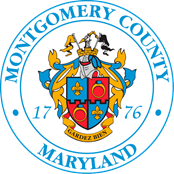Bright Spots
Submit your Bright Spot storyKendra Jochum | Department of Correction and Rehabilation
Kendra improved the outcomes of incarcerated individuals as they return to our communities. She's making sure inmates are referred to programs and services quickly after their initial incarceration so they can use more opportunities to improve their success following release. She's also re-focused her team on inmates as their primary customer so that tours and staff meetings don't reduce the amount or quality of time case managers spend with the people they serve.

Erik Bergmann | Department of Transportation
Residents were waiting too long for answers to simple questions as arborists struggled to keep up with calling residents back with answers that didn't have to do with their areas of expertise. It was in everyone's interest for arborists to focus on trees; instead, they had massive backlogs of calls to return on status updates and other issues. Erik redesigned door hangers and worked with MC311 so residents get faster and better responses while freeing up more time for improved results with our trees.
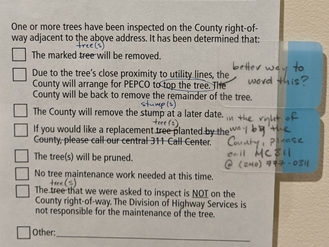
James Donaldson | Montgomery County Public Libraries
James reduced the average time it takes for new materials to reach library branches from 4 to 6 months to 1 to 2 weeks.
Libraries also analyzed recurring backlogs in the sorting room of their warehouse. Adults with Autism, in collaboration with CSAAC, a local non-profit, do the sorting.
They worked with CSAAC to rearrange the workspace and improve their sorting process. This eliminated the backlogs. Now, there's complete daily turnover in the sorting room.
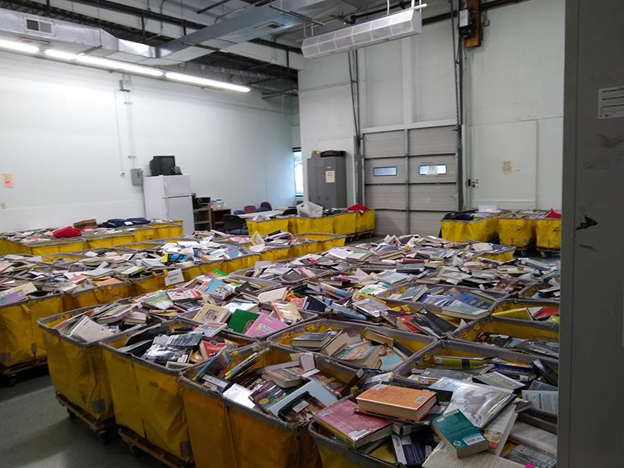
The warehouse before the process improvement
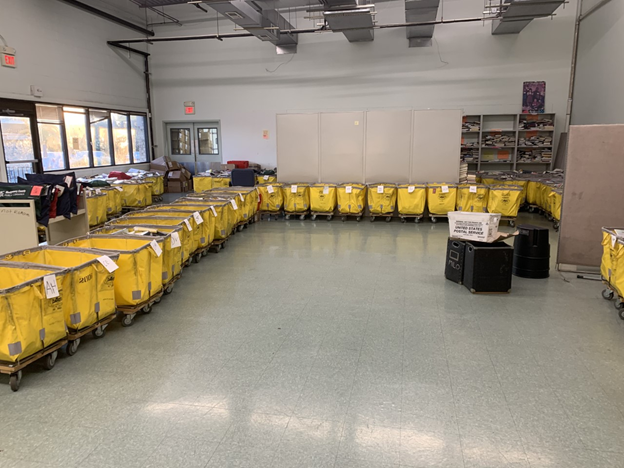
The warehouse after the process improvement
Jessica Jones | Board of Elections
Jessica made it easier for Early Voting Volunteers to ensure everyone’s voices are counted – without waste! She used behavioral insights to make the process easier for our valued Election Judge volunteers and the Early Voting Recruitment Team.
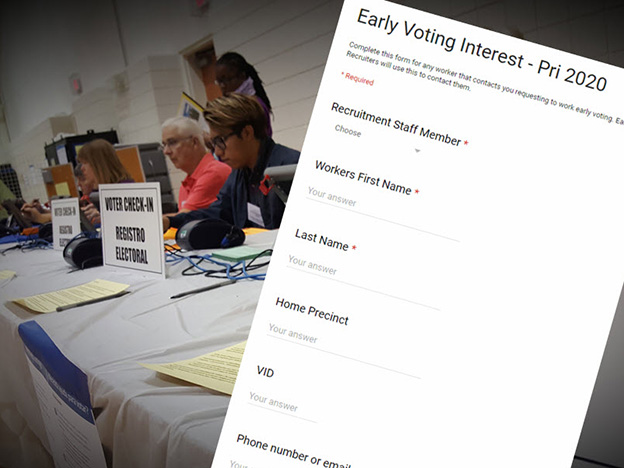
A Better Call Experience for Library Patrons
Accelerator: Nalani Devendra
Focus Area: Constituent Experience
Annual Savings (staff and customer time): $14,040
Patrons calling the library often couldn’t get the help they needed right away, frustrating them while tying up staff time and phone lines...leading to longer hold times and more missed calls. This also lead to longer wait times for walk in patrons. A root cause analysis identified an opportunity for a series of small changes that reduced the times patrons called without their library card which delays service delivery. This freed up staff time, reduced dropped calls, and improved the library patron experience.
Increasing Level of Satisfaction with Technology Services for Libraries Customers
Accelerator: Lilia Samusenko
If we consolidate office supplies at the shared (Technology) space, then we might
- reduce customers' and staff's time and energy in locating/producing office supplies when using printing/ scanning/ copying (Technology) services;
- decrease lines and customers’ waiting time in lines at the Customer Service Desk;
- free up staff at the Desk to assist more customers that can only be assisted in person.
Lessons learned:
- Standardized list of commonly asked for and provided office supplies is an effective step towards scalable solutions.
- Managing customers’ expectations through transparency - what’s on the table, is what’s available - increases level of customers’ satisfaction.
- Making things easier to accomplish leads to a happier environment.
In support of MCPL's strategic goal to continually improve and adapt library services and spaces to meet customer needs.
Driveway Apron Repair Payment Processing
Accelerator: Melissa Garner
Focus Area: Constituent Experience
Annual Staff Time Savings: Approximately 10 hours of staff time and $300, depending on project characteristics.
Previously, the effort to process a property owner’s check payment for driveway apron repair requests was inefficient causing confusion and delay due to the many people involved in the process, limited direction was provided to residents and county staff, and carried a level of risk with resident checks and information passing through the system. With the implemented changes, clear direction is provided to residents, fewer staff spend unnecessary time/effort to get a payment processed with the use of online payments instead of checks, and risk is limited due to the residents having full responsibility over processing their payment information online.
This change provided better service for the property owners to benefit from the driveway apron repair program and provided an opportunity to redirect county resources to other necessary work.
Improving Access to Behavioral Health
Accelerator: Leon Suskin
Status: In Progress
Access to Behavioral Health manages referrals from a dizzying array of people and organizations. The program provides a complete and appropriate response to each inquiry/referral. We currently spend $867.00/day spread over 22.6 hours of staff time to manage all of the referral/inquiries.
This project highlighted not just the inefficiencies accreting to this process over time, it also showed us opportunities to reduce burden on staff via better use of available technology, and revealed that our process had become captured by a few powerful referrers. We became aware of ways we could internally redesign this process to become more responsive to clients served directly.
MCDOT Director Office Correspondence
Accelerator: Heather Jeffries
Focus Area: Constituent Experience
Previously only one person was checking correspondence that came in to the Director’s office, this information was only tracked via email and would often get lost or forgotten about. We have created a system where the information falls into SharePoint and can be assigned to the correct group. We are also able to show the results and how the issue was resolved now and have it in one place instead of having to find emails.
This project has eliminated a lot of wasted staff working hours. By keeping the information in one place we are able to track responses without having to go through multiple people to get that information. Previously, one email could take up to 10 hours to get all of the results and responses.
Now instead of up to 10 hours, we can have the results in minutes.
This project has made it easy to track and log information coming in from residents. We are also able to easily track if certain areas are issuing requests for help more than others. This has been beneficial to both the department as well as for residents. Even though residents saw no change in how they contact the department, the department is able to get the residents answers quicker and be knowledgeable about past issues.
Furthermore, this system has sustained even as Heather has moved into a new role in a different department, spreading the change.
Automate Performance Measure Management
Accelerator: Samuel Buo
Focus Area: Employee Experience
Annual Staff Time Savings: $739 dollars per year, 13.2 hours per year
It was taking too long to determine the performance of Office of Consumer Protection’s Business Registration and Licensing Unit. The unit was taking too long to register and process business registrations, and the department undertook to turn that curve. At the time there was no easy way to determine unit performance without manually extracting data from spreadsheet exports and performing detailed computations. It took on average 33 minutes to manually generate performance statistics. After using the innovative framework detailed in this A3, I was able to create a PowerBI dashboard to provide on-demand unit performance, saving me time and making our unit more efficient.
This project saved 13.2 hours annually from having to determine unit performance. Because of the dashboard, we were able to quickly determine areas for improvement and have been able to reduce our department performance measure “Days to Issue Registration” from 22 days in 2019 to under 5 days in 2023. This allows Montgomery County businesses to receive their business registrations faster and gets them back to running their businesses.
Speeding up Hiring by Improving the ‘Position Description’ Process
Accelerator: Brian Hawley
Estimated 1 Year Soft Dollar Savings: Employee Experience
In order to hire a new employee, managers are required to create a position description - we made it easier. Surveyed participants stated that the Position Description form took up to 18 hours to complete. Submission of 33 position description forms for the recent Program Manager Group study saw high rates of error and missing data; 48% were missing required data or signatures and 18% contained erroneous data (data validation and/or lack of understanding of how to choose selections); 15% of the submissions used the incorrect/old form. We streamlined the process, shortened and error-proofed the form, put it in Seamless Docs where we can capture usable data. Reduced missing fields/signatures 100% and decreased signature processing time from 18 hours to 4.33 hours (goal was 10 hours).
What’s Next:
We’re working with OHR IT to create an in-house application that will add further efficiencies, such as connection to the active directory and access to Oracle position and employee data for look-ups.
We didn’t have data on completing the entire form because it was in Word. Now we have a creation time and can see that the average is 111 hours, with a median of 33 hours. It’s a long form and requires a fair amount of research prior to completion. There are a few outliers where a director received but didn’t sign for 2-5 weeks. That’s a potential waste error, they obviously need a reminder or some other method of pushing it through.
This project is the first step toward building a complete position description repository. The Classification and Compensation teams will be able to use the data in the repository to make better, faster data driven comparisons and decisions.
Accelerating Hiring Through Automating Backend Processes
Accelerator: Brian Hawley
Estimated Annual Savings: $9,000-$12,000 in staff time
Hard Dollar Savings: $4,000 in reduced technology fees
Additional Impact: Reduced time to hire and decreased errors with selected candidates
Recruitment staff and hiring managers struggled with manual processes and significant administrative burden which slows down hiring and causes us to lose top candidates.
The recruitment tracker app suite simplifies the recruitment process by collecting data through an intake form and feeding it into a PowerApp. The app suite is easier to use for recruiters and CORE, who can retrieve data using a dashboard with filters. The app can also generate mail merged offer letters that includes relevant language based on the record, which was previously not available.
Before this project, offer letters to candidates were being manually updated, leading to both errors and delays in offering candidates positions after they had been selected by a hiring committee. This project was completed with no new technology, saving $4,000 year in premium subscription costs by finding a work around using standard features.
Improving Equity in Interview Panel Staffing
Accelerator: Melissa Garner
Focus Area: Employee Experience
For equity in hiring, we look for diverse demographic representation on every interview panel. This sometimes has negative effects internally as it unduly burdens women and people of color who are already under-represented in high-level positions.
Interview panels are not always composed of the right people. My experience has shown that the consideration needed for who should/could be on an interview panel has not gone beyond who someone is used to and meeting the diversity requirements for a panel. If consideration of subject matter experts, grade level of panelists required for the position in question, and ability to increase the pool of interview panel candidates were taken into account, there is potential for significant savings per each interview panel. I used a personal scenario for my Accelerator project and for that one position interview process, $30,000 could have been saved if more thought had been put into establishing the right interview panel.
By evaluating the need for the interview panel, M3s would gain time back to focus on higher level responsibilities: $52/hour going to management production instead of sitting in hour-long interviews.
This A3 was more of a personal item because I was a female M3 asked to participate on many interview panels because I could check off two requirements: diversity with a female on the panel, and I was at a grade that could meet the interview panel requirements for not being able to hire above your own grade (I was at the top, so I could essentially hire anyone). Neither consideration of whether I was a subject matter expert nor if an M3 was actually needed on an interview panel for a lower grade level position was not taken. This frequently took my time away from handling management items for my position.
eTelework Roles up-to-date
Accelerator: Emily Danyluk
Focus Area: Employee Experience
Not processing telework applications was leading to employee disgruntlement and lowered the overall administration costs. All Departments appoint at least one person to each of the following roles: Telework Management Officer (TMO), Department Director/Designee, and Point of Contact (POC). However, before the start of eTelework renewal season, at least 8% of departments did NOT have a director designee listed in the system to approve applications and more had out of date TMOs. This would have led to significant delays in processing applications. In doing a 5 Why’s root cause analysis, it was thought that maybe roles weren’t being kept up to date because roles weren’t visible. How could this be more visible? Changes were implemented to make the roles more visible.
We implemented changes that led to:
- User role assignments are more visible to departments and program administrator, creating smaller time gaps when there is a user role vacancies.
- Telework applications have less risk of getting “stuck” due to someone on extended leave or a user role vacancy.
- Employees know that their applications are being seen and processed.
These are simple innovations, but they prove the method. I also used the same structured process to pilot and test the CPU position in OHR (reducing response time in creating/reclassing positions and improving customer services). I am currently using them in my new department.
Reducing the clutter in telework appeals appointment scheduling
Accelerator: Emily Danyluk
Focus Area: Employee Experience
During the first year of the new Telework Policy and associated appeals process, it became obvious that a change was needed when four Step 2 Appeals appointments resulted in 11 re-sends – despite only scheduling when calendars showed the participants as available. Several steps were taken and starting with a 275% error rate, the rate dropped to 33% and then 0. Innovations that were implemented including naming alternates to the panel and periodic instructions for panelists to ensure calendars were updated.
Employee concerns were heard and resolved faster - and they weren’t subjected to a barrage of reschedules that could make it seem like everyone was “too busy” to help resolve their issue.
Improving Telework Tracking - eTelework 2.0 Upgrade
Accelerator: Samuel Frushour
Focus Area: Colleague Experience
To telework, our colleagues complete an annual agreement that clarifies expectations and strengthens collaboration. The process for registering was burdensome for colleagues and the staff managing the system. The original eTelework system was a single-application system, so an employee could only submit one application in their lifetime. System was reengineered to allow for seamless renewals and lesser amount of clicks using auto-populated data from Oracle as well as previous submissions from the user. The new process significantly streamlined the user experience and reduced amount of time OHR needs to spend administering the logistics of the program.
OHR File Storage Reduction
Accelerator: Samuel Frushour
Focus Area: Employee Experience
We were drowning in past paperwork. OHR was using paper processes for almost all programs up until 2020, without a consistent practice of reviewing and dispositioning files. By 2020, the hallways of OHR’s 7th floor suite had 35 filing cabinets running the aisles. Within six months of review, all 30 cabinets were completely emptied and surplused, and a dedicated file storage room with dedicated review periods was established. This project used the 6S Accelerator tool.
Fast and Correct eMultilingual Certificates
Accelerator: Emily Danyluk
Focus Area: Employee Experience
Annual Staff Time Savings: $1,400
To ensure constituents find information in the language they understand, we encourage multi-lingual employees and certify their language skills for additional pay.
eMultilingual Certificates were being sent to employees and departments using email templates in Word documents but copy & paste from Word to email was cumbersome and the formatting sometimes got lost. As a result, previously sent emails were just updated with new information. However, if all data fields didn’t get updated, the certification email would be subtly inaccurate.
As result, the following was implemented: making the mistake more visible so burden to find them (previously on MCTime) was reduced. This was done by creating multiple email templates as a signature file for the certifications to expedite sending – faster than copy/paste from Word. (Currently at 2 minutes, 10 seconds, compared to 10 minutes previously with cross checking and double checking data). All new templates had BLANK fields in orange, so lack of update makes the error one of omission (not incorrect information) and more visible.
Before leaving OHR, updates were made to the eMultilingual system so that certificates were automatically sent the moment that the person was marked in the database as qualifying for the differential.
The process is now fully automated and we also had time to implement updates to pull reports automatically and produce automated reminder communications to keep the process moving.
We estimated that 2/7 certificates previously had errors. This dropped to 0 and saved significant staff time
Trainings Attendance Sheet Submission
Accelerator: James Hawkins
Focus Area: Colleague Experience
Estimated Annual Staff Time Savings: $4,160 per year (Our innovation saves about 2 hours per week x 30/hr for a total of 240 soft dollar savings per month. )
Prior to our innovation, instructors would email attendance sheets to the OLM inbox. This would cause attendance sheets to be lost and delay changing employees training record in the system. There was also no ability to track when we received an attendance sheet or how long it took.
We now have automated the process and also can notify instructors when their attendance sheets have been entered in OLM. We also do not have to email each other back and forth asking for attendance sheets submission. We have also been able to close out classes more quickly.
Rapid Launch of COVID-19 Testing Compliance System
Accelerator: Samuel Frushour
Focus Area: Colleague Experience
COVID Testing for non-vaccinated employees ensured a healthy workforce ready to deliver for residents with reduced risk of contagion. Council passed a law mandating COVID-19 testing for County employees that were not vaccinated. Once CBAs were signed, OHR had three days to develop and deploy a solution to track compliance of the testing program. Within three days, OHR launched a system used by 2100 employees for weekly COVID-19 testing results, resulting in a significant increase in COVID-19 vaccination rates at time of program close.
How do we best collect information regarding outreach and engagement efforts for Department of Environmental Protection?
Accelerator: Larissa Johnson
Focus Area: Colleague Experience
The Department of Environmental Protection has a few outreach programs and positions and we are all using different platforms and resources to report our interactions with the public. This Accelerator project was created to see how we might reduce the administrative burden of data reporting while increasing accuracy.
A reduction in time by 83% translates to the same reduction in payroll expense wasted waiting for the existing process.
Currently, there are 14 FTE staff who have to submit data to the tracker. Their time differs based on their role but there are Grade 23-28 submitting information. For every 100 events, this takes 20 hours of staff time.
How might we encourage "weak ties” in MCG?
Accelerator: Susanne Brunhart Wiggins
Focus Area: Colleague Experience
When people connect with others they don’t typically interact with, results include increased diversity, knowledge, happiness, and sense of belonging (Granovetter, Weak tie theory). Innovation and new ideas flourish when people from different backgrounds come together (Johansson, the Medici Effect). Such outcomes strengthen organizations. We needed a way to bring MCG’ers together, across departments, workplace geography, skill areas, and more, especially with remote work. As of May 2023, 124 MCG’ers from 26 departments have been matched for 362 conversations!
Business Education and Registration Unit (BEAR)
Accelerator: Shaun Carew
Businesses often try to do the right thing but struggled with burdensome government processes that didn’t achieve their purpose of protecting consumers. Previously, the Office of Consumer Protection would only issue registrations and investigate complaints after receiving applications and complaints from consumers and businesses. To address this issue, the Business Education and Registration Unit (BEAR) was established to proactively locate unregistered businesses, provide education on registration requirements, and guide them through the registration process.
The BEAR unit has a positive impact on businesses by proactively identifying unregistered businesses and providing them with the education and guidance they need to become compliant. This helps businesses avoid potential legal issues and financial penalties, and promotes fair competition in the marketplace. In addition, the BEAR unit generates revenue for the organization through registration and compliance settlement agreements.
Overall, the creation of the BEAR unit demonstrates the organization's commitment to ensuring integrity in our marketplace, and to providing excellent customer service to businesses and consumers alike.
Improving the Department of Environmental Protection’s Translation Process
Accelerator: Ana Arriaza
How might we make sure our websites are in languages people understand, without overburdening staff who speak more than one language? DEP has a handful of County Certified Spanish translators. In the past, each translator had been asked to translate written materials for different DEP staff as needed. This created a system where only certain translators were being asked to translate materials because someone was familiar with them or because staff didn’t know who else they could ask. We had no way of knowing how many translations were being done, no way to ensure they were quality translations, and no way of ensuring everyone (regardless of country of origin) was using the same terms that are relevant to the Central American Spanish speaking community in Montgomery County. For this project, we created a way to cycle through all of the translators at DEP, installed best practices by including time for a second person review the work in the translation process, created a list of commonly used terms for all translators to use, set translation timeframes (which included reviews) and with DEP IT created a database to track and help with the process.
Now, DEP has a system with guidelines for staff to follow, along with protocol on where to translate materials based on number of words, a tracking system for translations, a way to ensure everyone is using the same terms, a translation turnaround time of 5 days (limited length of documents) and a way to ensure all translators are being utilize and not one translator is being over burden.
On an annual basis, some staff were receiving about 32 translation requests. The new process has made the translation process a lot more equitable in terms of translator’s time.
Reducing the Burden of MyGreenMontgomery Website Updates
Accelerator: Larissa Johnson
Annual Staff Time Savings: $3,000
There are five (5) outreach staff (Cat, Cindy, Ana, Mary, and Larissa) who update the My Green Montgomery website with content. How do we better manage the homepage to determine what is seen by residents and for how long because we want information that is timely, balanced, and relevant to DEP campaigns on the homepage?
Previously, we emailed each other randomly when we needed to update the home page which means we spend a lot of random time on this, roughly 50 hours per month. Recognizing this challenge, we implemented a series of changes including a system to monitor and track the homepage posts. We meet bi-monthly to ensure that everything is running smoothly and to sustain the change. We are saving over 40 hours a month in reduced coordination costs. Further, we created a protocol, we no longer send out emails, and everyone is in control of their own outreach. Constituents now find information in a timely manner and staff can spend more time engaging them towards a green Montgomery County.
MCDOT Admin Resource Calendar
Accelerator: Heather Jeffries
MCDOT is a large department that is in many locations. Administrative staff were not connected to know when someone was on leave. This created the problem of urgent requests sitting and waiting until the admin would return from leave. For this project, we created a Microsoft Teams group as well as a shared Calendar where everyone can enter their leave and who will be providing coverage.
This saves time by ensuring that information goes to the correct people so that we can get residents answers super quick.
We also have made it so the Admin Team is more of a team. This project has enabled us to know who to send information to and who we can get answers from. Before we would leave messages or send emails and they would go unanswered. Now we can see who is where.
Growing a Citizen Developer Community to Use Existing Technology to Solve Challenges
Accelerator: Anna Ye
Year 1 Soft Dollar Savings: $75,000
Montgomery County used to purchase 3rd party software or hire developers and project managers to build customized software and improve processes. It takes 3- 5 months and 10 - 30 thousand dollars to build the software and improve the processes. Sometimes, the software does not capture the business flow accurately and the project became a waste. Instead of building new software, we train process owners to use existing office365 and other tools to automate the process and improve job performance. It usually takes 3-5 weeks to achieve this automation with no extra cost.
In the first year, the initiative started small with three citizen developers that had a direct impact on the constituent experience
- Mobile dental project for estimated savings of $50K per year;
- File sharing: estimated savings of $5K per year;
- Correspondence log estimated savings of $20K per year.
In addition to each project, the citizen developer program intentionally creates space for staff to learn from each other. Staff are building solutions that their colleagues notice and copy.
How might we reduce the number of unique styles for redesigned websites?
Accelerator: Susanne Brunhart Wiggins
Estimated Soft Dollar Savings in Year One Implementation: $19,200
Residents need websites that are easy to navigate with information that is easy to understand and meets their needs. Our emerging MCG web design system unifies visual design, speeds development, and supports branding. Using vetted code and colors ensures accessibility, too! When Human Resources needed a new home page, it took 10 minutes(!) to create the draft. The Business Center website, relaunched in early 2023, has the design system at its core.
Improving the vendor experience for Local Small Businesses
Accelerator: Grace Denno
Estimated Annual Savings: $5,000 in staff time for County and small businesses
Vendors need certification to access certain means of doing business with the County. A confusing certification process left local small businesses lost. It caused frustrating duplicative efforts for certification. Procurement removed confusing spaces and reduced the effort for certifications, impacting 120-180 small businesses each year.
Improving Collaboration with Suppliers
Accelerator: Kori Wennan (Mo the Elephant Award Winner)
Annual Hard Dollar Savings: $1,200 in printing costs
Annual Staff Time Savings: $29,400 over the course of a year
Focus Area: Constituent Experience
Alcohol Beverage Services (ABS) started partnering with suppliers and other wholesalers to create sales driving programs and displays in Retail stores. Since the start of this approach, there have been many last-minute additions as well as incorrect information. This resulted in a lot of frustration, confusion, and additional printing cost and working cost to adjust pricing and communication.
Since the implementation of a defined and outlined process in addition to a new streamlined form, we are able to receive information faster and more inline with what we need to make operational decisions. This has resulted in more robust programs with nearly full elimination of errors. This has also provided additional opportunities for local, women-owned, and minority-owned businesses to be featured as part of Retail monthly or quarterly programs.
This Accelerator project has continued to evolve and improve. With the tools developed through the Accelerator program we have been able to partner with our wholesalers to improve this process over and over again. It has fostered long term beneficial relationships with other departments and some of our most important customers. This has also spanned other Accelerator projects that are in process and look to benefit overall Operations both from hard dollars and soft dollars.Improving Work Areas and Reducing Burden
Accelerator: Kathie Durbin
The Alcohol and Beverage Services licensing training room was often left in disarray, which left some employees annoyed. Employees who had to clean up the mess were angry. Users of the room did not know how to leave the room or what was expected of them. We used root cause analysis, 6S, and visual management standards of work to make improvements saving $3,000 of licensing staff employee time. We moved away from conflict and resentment by implementing clear instructions for use of the room, pictures of the correct arrangement of furniture and equipment, and non-verbal reminders.
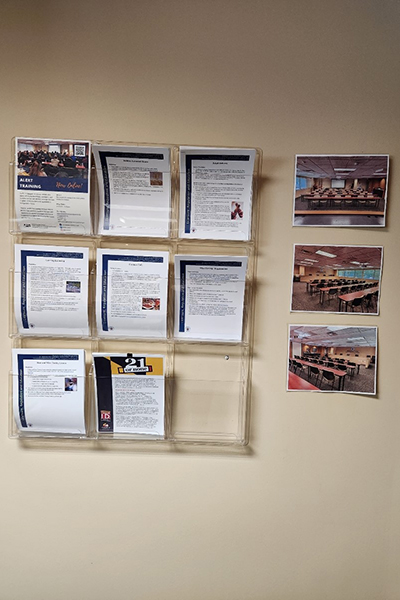
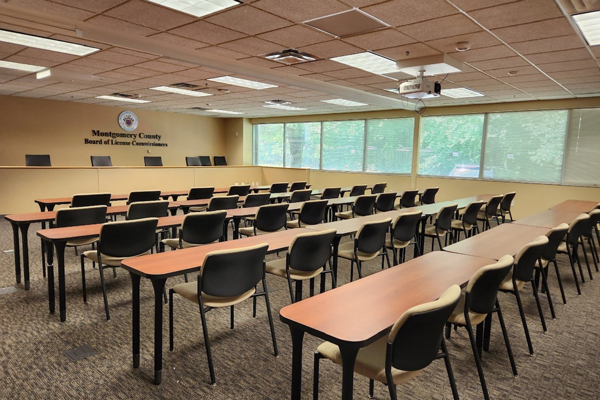
Reducing Alcohol Beverage Services ALERT Class Enforcement at Renewal Time
Accelerator: Jocelyn Rawat
Focus Area: Constituent Experience
Annual Staff Time Savings: $2,000
Let’s keep small business of Montgomery County focused on growing their businesses, without sacrificing consumer safety. Alcohol vendors have to take an ALERT class for their renewal, but often forgot, leading to a last-minute scramble before their renewal.
In an effort to reduce the workload and stress level during the extremely busy renewals period (February-April annually), we conducted root cause analysis. We discovered that several businesses had not taken the required ALERT class, which caused the staff to use valuable time enforcing the class mandate during the busiest time of the year and caused businesses to have to scramble to take the class at the last moment. By implementing regular reminders and clarifications of the policy, the staff was able to distribute enforcement tasks throughout the year, thereby saving time during the busy renewals period and preventing last-minute surprises for businesses.
Routine reminders saved time and stress during the busy renewals period for both staff and small businesses.
Reducing Backlog of Filing at Renewal Time
Accelerator: Jocelyn Rawat
Focus Area: Constituent Experience
Annual Staff Time Savings: $7,000 (40 hours of Administrative Specialist 1 for $2,000, $3,000 for Program Manager 1 for $3,000, and 10 hours of Alcohol Inspector for $2,000)
Annual Hard Dollar Savings: $1,080 (20 hours of contracted administrative aide for $800 plus $1000 in printing/parchment costs)
In an effort to reduce the workload and stress level during the very busy alcohol license renewal period (February-April annually), we conducted a root cause analysis and discovered that there was a backlog of unfiled paper renewal applications. Although the backlog was less than 1% of the total, unfiled applications wasted a disproportionate amount of time when they were needed for corrections or inspections.
Because we analyzed the alcohol license renewal processes right before the pandemic hit, we were well positioned adapt to the needs and opportunities created by the Governor’s Executive Order that dramatically impacted licensure across the state. We quickly implemented the three projects identified through the Accelerator and added several from the brainstorming list. These process changes precipitated several more, and taken together, the revised renewals program ultimately received a NACo award for responsive government.
By incentivizing and enhancing the online renewal portal, the percentage of online submissions grew from 12% to 90%, making filing unnecessary for the vast majority of applications.
Reducing Errors in Alcohol Applications
Accelerator: Jocelyn Rawat
Focus Area: Constituent Experience
To keep our residents safe, Alcohol and Beverage Services renews 1,030 licenses each year to ensure those serving alcohol do so responsibly.
By analyzing the process and reducing spaces for error, this project created significant savings to businesses who might have to make retroactive corrections or attend a hearing for $600 plus lost revenue if there is a lapse in the license. Additionally, it saves significant staff contractor time. This project was completed in January 2020 with implementation scheduled for the February-April 2020 renewal period. The pandemic hit, and all processes were disrupted for the next two renewal cycles. Having analyzed the process and brainstormed solutions in advance of that disruption, we were able to pivot quickly to implement the projects from the Accelerator course and expand to other areas.
Analyzing these processes before the pandemic hit was a game changer. The pandemic created needs and opportunities for improvements, and I was able act quickly having already thought through the concepts. These process changes precipitated several more, and taken together, the revised renewals program received a NACo award.
While the initial project had positive results, the real results are so much more interesting. Fast forward to 2022 and all three licensure specialists left the department near the beginning of the renewal period, leaving me to do the work of four. Because so much of the process had been automated over the previous two years, I was able to pass some of it to untrained staff. That still left a lot for me to do, but I was able to do it so much faster with the new process. It was hard, and there were problems, but the 2022 renewals were completed. This would not have been possible without the automation that grew out of the Innovation Accelerator. The renewals would have failed (and I along with them). This is a much more meaningful result than a couple thousand dollars.
And in 2023, renewals were handled by an entirely new team, building on the improved processes from this series of Accelerator projects.
Reducing Errors in Issuing Certificates of Completion for Alcohol Licenses
Accelerator: Kathie Durbin
Focus Area: Constituent Experience
License holders and their employees who took the department’s ALERT class did not always receive their certificates of completion because of registration confusion, a participant’s choice not to register, or difficulty reading handwritten registrations.
An automated process made class participants responsible for entering their own information and downloading their own certificates, thereby reducing mistakes and staff time.
This process continued and evolved into an entirely virtual process in response to the pandemic. Having started the automation made it easier to pivot quickly when it became necessary.
Reducing Errors in Issuing Certificates of Completion for Alcohol Licenses
Accelerator: Kathie Durbin
In an effort to streamline processes, we discovered that projects would break down as they moved from one division/section/department to another because of dropped communication, confusion, duplicated efforts, or incomplete tasks at a previous step.
By breaking down the silos, we were able to share knowledge, network, build relationships, and share the ownership of tasks. Steps included improving knowledge base articles for Communications Center, updating CountyStat and training existing staff.
